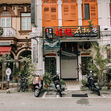NST: Factor in COVID-19 in the design of our cities
- PEREKABANDAR

- Jun 30, 2020
- 2 min read
Covid-19 has impacted urban communities to a degree that many cities are bereft of quality urban life.

Parks allow easier movement for people in line with social distancing. - NSTP/MOHD YUSNI ARIFFIN
The Movement Control Order (MCO) has left our streets, public spaces, and buildings void of dynamism and energy, which is a cause for concern in any urban design exercise. However, it has provided us the opportunity to reflect on how cities should be designed based on the new normal of social distancing and high standards of hygiene. The issue of Covid-19 now needs to be factored in the design of our cities. The Malaysian Urban Design Association (PEREKABANDAR) was established just before the enforcement of the MCO, and its aim is to champion high standards of urban design practice in the country.
The society was established to address the poor quality of urban spaces and cities in Malaysia, which, in regards to character and identity, consequently affect people's quality of life and sense of belonging. PEREKABANDAR views the challenges of the post-COVID 19 pandemics as a new set of challenges for urban design. Social distancing is a "new culture" that can be difficult on the streets and other public spaces which form the key elements of urban design. Passive ways of reminding people to keep their distance through the creative use of landscape furniture or creative pavement patterns are needed.
Sidewalks, five-foot walkways, and streets need to be more flexible with a wider leeway to accommodate social distancing. The concept of shared spaces can help to increase urban mobility so that active modes of transportation such as cycling and walking on the street itself can be the new culture of movement within cities. When working from home becomes the new norm, large public car parks can be a thing of the past. Some of these car parks can be converted for other uses. Linked with other urban spaces, they can be more comfortable and conducive for walking, cycling, and exercise, complementing existing public parks that are otherwise at risk of crowding.
The important nodes of a city such as marketplaces and transportation hubs, which tend to attract crowds, should be prioritized for upgrading. These spaces are often cluttered, dingy, and poorly ventilated, becoming potential breeding grounds for the virus. The new norm requires the facilities and furniture of these places to be reorganized to allow social distancing. Efficient sanitation methods and a good solid waste management system should also be in place. However, this should not detrimentally affect the market as a place reflecting the true culture of a society and our way of life. While Milan in Italy and Bogota in Colombia have attempted to deal with Covid-19 by reclaiming space from their streets to accommodate cycling and walking, such an effort has yet to be seen here.
Nonetheless, we have to start adapting our cities to accommodate the resurgence of urban life with the new norm in mind.
Dr Shuhana Shamsuddin
President Malaysian Urban Design Association
Published by New Straits Times











Comments